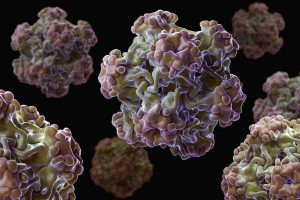High-risk oncogenic HPV: what is the danger?
 Ordinary wart and malignant tumor – what do they have in common? No, no, the wart does not turn into cancer. However, there is something that unites them – is HPV, human papillomavirus, or papillomavirus.
Ordinary wart and malignant tumor – what do they have in common? No, no, the wart does not turn into cancer. However, there is something that unites them – is HPV, human papillomavirus, or papillomavirus.
What is HPV?
Under this name hides a whole group of viruses of general nature, containing DNA. There are 27 species and about 200 strains. Indicate their numbers: HPV (HPV – human papillomavirus) 1, 2, 16, etc.
An absolute majority of the world’s population is infected with these viruses: according to scientists’ estimates, from 70 to 90%. But for many, the virus does not manifest itself in the course of a lifetime and can only be detected by chance. In such cases, talking about the carrier.
Infection of HPV occurs through everyday and sexual ways. A newborn can get the papillomavirus from the mother during labor.
HPV Oncogenicity
Not all papillomaviruses are equally dangerous. So, there are viruses that cause various warts: ordinary, plantar, flat. They can cause discomfort, spoil the appearance, but do not pose a serious threat to health. But some of the HPVs are oncogenic, that is, they promote the degeneration of the body’s cells into malignant ones.
According to this criterion, all types of HPV were divided into viruses with low, medium and high oncogenicity.
This is the most dangerous type of virus, especially often it affects women. If the immune system is strong enough, then the virus can remain in the body without causing any symptoms. Signs of infection appear on the background of weakened immunity, after a serious illness. It:
High oncogenic viruses, that is, a high risk of developing a malignant neoplasm, include HPV 16, 18, 31, 33, 39, 50, 59, 64, 68, 70. The 16 and 18 types are considered the most dangerous. By activating, they insert their DNA into a human cell, reprogramming it and thereby causing abnormal cell division.
HPV 16
round warts on the palms and soles of the feet;
papillomas in the groin and armpits;
genital warts on the labia and anus;
spotting from the vagina, more often after sexual contact.
HPV 16 can lead to pathological changes in the cervical mucosa, its cells regenerate and begin to divide rapidly, which is already a precancerous condition (dysplasia, or cervical intraepithelial neoplasia).
HPV 16 can lead to cancer of the uterus, skin.
For men, the 16th type virus is less dangerous: only in 1% of cases cancer of the genital organs – the penis or the testicles – occurs.
HPV 18
Like the 16th type virus, it belongs to the most dangerous papillomavirus and also contributes to the development of cervical intraepithelial neoplasia.
In addition, HPV 18 causes bovenoid papulosis, which, if not treated, can turn into cancer. Bovenoid papulosis is manifested by red, purple, yellowish formations on the external genital organs, which are accompanied by severe itching.
For men, HPV type 18 is dangerous due to the development of Bowen’s disease – the appearance on the head of the penis is a red plaque that can develop into a malignant tumor.
Is it possible to get rid of HPV
It is believed that it is impossible to completely remove the virus from the human body using the means available today. But this does not mean that you do not have to fight him. Treatment for papillomavirus includes:
removal of formations;
antiviral therapy;
immunity strengthening.
But sometimes the virus is not detected in the patient after the treatment. This means that the body itself has destroyed the enemy.
Before starting treatment, determine the type of papillomavirus. This can be done using PCR.
To remove papillomas use a laser, electrocoagulation, cryodestruction, or cut out education surgically. Cauterization of warts with chemicals is also used.
Although antiviral drugs do not completely destroy the virus, they can reduce the viral load.
Immunomodulators are sometimes used to support the immune system.
Treatment in each case is selected individually, taking into account the type of virus. That is why you should not try to get rid of papillomas yourself, with the help of folk remedies, this can only be harmful.



